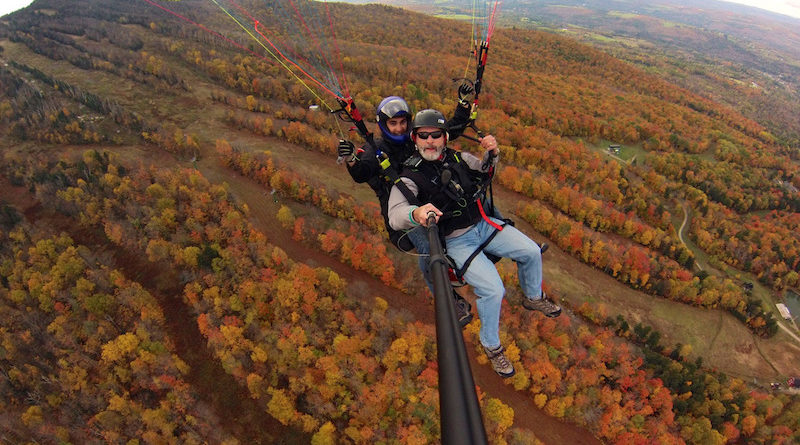6 Ways to Build Your Mental Muscle
We asked an expert climbing guide, a sword swallower and a paragliding instructor how they handle fear. Here’s what they had to say.
Most outdoor athletes, whether they are just starting out or experts, will tell you that fear is something they deal with often. Here are six tips to help you take your performance to the next level—whether that’s on the sharp end of a rope, in the office or getting ready to drop into a big line.
1. Find a Good Mentor
Whether you’re a paraglider, rock climber, backcountry skier or paddler, you can’t push your limits if you aren’t confident in the skills you have to mitigate the risk of failure. “One of the most useful development tools I’ve found in high consequence sports is having a good mentor who can keep a close eye on you and give direct feedback in the moment,” says paragliding instructor Calef Letorney. In paragliding, Letorney does that by talking to a student through their flight via radio from the air.
Petra Cliff’s Steve Charest echoes this with rock climbing. “I try to teach my students to communicate clearly what they’re feeling early on,” he says. “I’ll often ascend a rope next to a new lead climber and talk with them about each piece of protection [removable gear that anchors a climber to the rock as they move up a face] as they

place it. That way, we both know that we’re managing the risk… so they know what it looks like to push themselves within a reasonable set of parameters.”
2. Don’t Expect or Try to Overcome Fear
“Erase the mistaken notion that you have to eradicate your fear,” says Roderick Russell, a climber and one of the world’s top sword swallowers. “Regardless of how accomplished you are, you will deal with challenging thoughts. Practice self-distancing and find tricks that help you keep your focus on the task ahead of you while you let fearful feelings or thoughts come and go.”
For recurring fears, such as the fear of getting pumped out and falling at the start of leading a climb, Russell recommends naming them. “Literally call it Ted. Then, when the fear comes back, say, ‘Hey Ted. Nice to see you again.’ Or, you can try playfully thanking your brain for the observation. Once you do that, it becomes a little easier to redirect your focus to the task ahead of you.” His other tip? “Laugh at yourself a little when you feel afraid.”
3. Be Task Focused, not Self-Focused
Russell teaches his clients and workshop participants to practice what he calls a “noticing” mindset. “Often when we have a fearful thought, we start spinning stories. It could be that we will fall if we try that next climbing move, or that we can’t accomplish the task ahead of us because of x, y, or z, and those narratives are distracting” says Roderick Russell. “Learn to recognize that feeling. Accept the information it offers you. Then, if you can distance yourself from the emotion that comes with a thought, you can separate your sense of self from it, treat it with objectivity instead of emotion, and refocus your energy on the task ahead of you.”
4. Set Process-Oriented Goals, Not Outcome-Oriented Goals
While ambition can be a useful tool, Russell recommends setting goals around the way you engage with a sport rather than outcomes such as climbing at a particular grade or conquering your fear. “With an outcome-oriented goal, your vision of success is always in the future. But if you focus instead on a set of values that guide the way you move toward a given goal, you’ll find more satisfaction in your sport and likely make more progress,” he says. For example, focus on climbing fluidly and efficiently, or as smoothly as possible, rather than on the full scope of the task of completing a challenging project or reaching the next grade.
“Play the long game,” says Letorney, who, at 35 is still paddling big water and completed a 37-mile solo flight in 2018. “This is supposed to be fun, so play within your comfort zone. If you’re always operating at 80 percent of what you think is possible over the course of your career as an athlete, you can accomplish a whole lot over a long career.”
5. Practice Makes Perfect
“At some point, you have to put yourself in a moderately stressful situation to practice these focus techniques,” says Russell. “You have to swallow the sword or get out on the rock.” He says the key is to do it in a setting where you are comfortable with the consequences of your failure.
For Russell, this means finding the perfect balance between stress and your ability. “You need to push outside your comfort zone but not so far that you flood your system with stress.” For example, you may practice self-distancing while lead climbing at a grade where you are confident, then pick a sport climb at the next harder grade with ample protection and an overhang, so a fall doesn’t mean you will hit the rock face. There, you can practice pushing your limits.
“Most people know deep down when something is scary and uncomfortable but probably doable, versus when it’s so far outside your comfort zone that it’s a hard ‘hell no!'” he says.
“A mentor can help with identifying that balance,” says Charest. “But stay on your toes. Make your own observations about what is safe and don’t be afraid to communicate with your partners or teacher. Together, you can make a decision about what is a reasonable amount of risk to take on.”
6. Don’t Be Afraid to Commit
“Once your skills are dialed and you’re in the act, and you feel you’ve mitigated the risk appropriately, don’t be afraid to enjoy the act of trusting your judgement and committing,” says Letorney, who offers the example of paddling a big rapid in a kayak once you’ve left the last eddy. “Sometimes, there’s nothing left to do but charge and there’s no place for fear once you’ve left that last bail out. Once you’re committed, sight it real hard and give it everything you’ve got,” —whether that’s taking a lead on a tough climb, steering your paraglider into a thermal or making a good decision in avalanche terrain.
For more about the science behind managing fear, see “How to Harness Your Fear.”
Steve Charest and Roderick Russell will both speak at the inaugural Vermont Climbing Festival, Sept. 20-22 at Cochran’s Ski Area. For more climbing-specific fear management tools, sign up for Russell’s clinic, “On the Edge: Mental Training for Climbers.”
Featured Photo Caption: Paragliding instructor Calef Letorney (left) is also a former whitewater kayaking national champion. He’s taught many to fly over the Greens. Photo courtesy Calef Letorney

